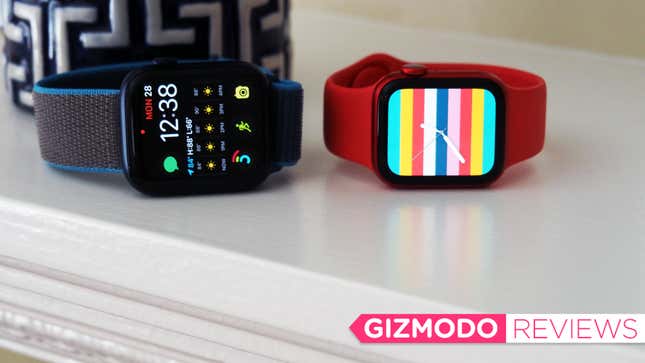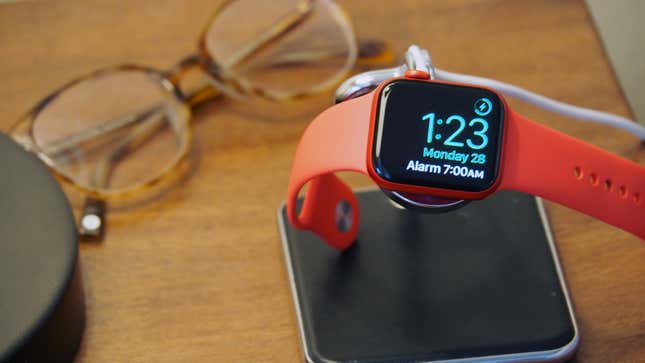
I’ve been wearing the Apple Watch Series 6 every day (and night) for almost two weeks, and it must be said: This is a good smartwatch. In fact, it’s the best smartwatch.
But I wore an Apple Watch Series 5 regularly prior to this, and a Series 4 before that, and using the Series 6 isn’t significantly different. Many of the watch’s new features come with software improvements in watchOS 7, which every Apple Watch dating back to the Series 3 benefits from. And the Series 6's marquee features, a blood oxygen sensor and a faster processor, don’t meaningfully affect the day-to-day experience.
I do think that sensor will eventually be important, and it hints at Apple’s future plans for the watch. But right now, my blood oxygen level is just another metric I have to hunt for in the iPhone Health app.
Let’s Talk About Blood
The Series 6 was redesigned to include the blood oxygen sensor. The watch’s back crystal now includes four clusters of red, infrared, and green LED lights, and four photodiodes situated between them. The red and infrared lights shine through your skin to the blood vessels beneath your wrist, and then the photodiodes capture that light. If your blood is dark red, it’s less oxygenated; bright red blood is more oxygenated.
You can take an on-the-spot blood oxygen measurement using the Series 6's new Blood Oxygen app. You have to sit completely still with your wrist placed on a surface in front of you, and then wait 15 seconds for a reading. If you move at all or if your arm is at a strange angle, then the reading will be off or inconclusive. I don’t have any known health issues, and my readings consistently came back at 95-100%. The spot checks are fine, but what’s really interesting to me is the continual level checks the watch does in the background, including while you wear the watch to sleep. My blood oxygen levels consistently range from 91-100%.

(There has been some question as to whether blood oxygen measurements may be skewed by skin tone. Anecdotally, my husband, who is Latino with brown skin, has no known health issues and his levels on his own Series 6 were consistently in the normal range as well.)
The Series 6's SpO2 sensor is not an incredible advancement for smartwatches. Fitbit’s wearables have included one for years. They aren’t capable of blood oxygen level spot checks, like the Series 6 is, but, like the Apple Watch, they don’t do anything with that data either. It’s just another metric in an app.
Apple launched three clinical studies with research partners alongside the Series 6 release to examine the link between blood oxygen levels and asthma, heart failure, and respiratory viruses (like covid-19 and the flu). If a link is found, Apple could then use those results to develop diagnostic tools and submit them to the U.S. Food and Drug Administration for clearance. But that’s a ways off, if it happens at all. Until then, you can use the Series 6 to keep on eye on your measurements, but the watch itself won’t actually tell you if there’s something to be concerned about. I’m excited about the Series 6's potential, but that’s all it is right now.
Still a Fantastic Fitness Tracker
Aside from the blood oxygen sensor’s capabilities, the Series 6 is packed with all the same health-tracking features you get in the Series 4 and 5, including the electrical heart rate sensor that enables the FDA-cleared ECG app (which can diagnose atrial fibrillation). And the Series 6 is an excellent fitness tracker, like the Apple Watches that have come before it. It’s single-handedly motivating me to be active during California’s ongoing pandemic-related lockdown, although I did adjust my Stand goal down from 12 hours to 10, because life is hard enough.
The Series 6's always-on altimeter (which is also included in the Watch SE) is neat if you’re a nerd when it comes to elevation. I used the watch to track a hiking workout, adding the elevation complication to the watch face, and it was pretty neat to watch my climb in real time from 350 feet above sea level to more than 1,200.
The watch also now tells you your Vo2 Max score, which is a measurement of the oxygen your body uses during exercise. A higher score means your cardio fitness level is pretty good. But the iOS Health app, where all of these metrics live, doesn’t tell you what a good score is. Mine ranges from 31-37, but I had to Google to see what that meant. (Apparently it’s fine. Phew.) The normal range varies depending on age and sex, which the Health app also doesn’t tell you. Given how much the watch knows about me, including my age, weight, heart rate, even when my periods happen, I expect it to give me more context about my health data.
And that’s my biggest issue with the Series 6. It’s capable of so much—tracking my sleep, monitoring my blood oxygen levels, measuring my cardio fitness—and yet it fails to contextualize those metrics for me. The Apple Watch is very good at measuring things. I just wish it would use those measurements to give me advice.
Improved, but Not Impressive, Battery Life
The question I get asked most often about the Series 6, aside from the health-tracking features, is about battery life.
An iFixIt teardown revealed that the Series 6 has a slightly larger battery than its predecessors, and in my experience, the watch lasts about 30 hours on a charge. That includes wearing it overnight to track my sleep and about 60 minutes per day of GPS-tracking workouts like outdoor walks and running. Sleep-tracking drains the battery by about 10% (when I used a Series 4 to track my sleep, that drain was closer to 20%). Is it the longest-lasting smartwatch you’ll find? No! Definitely not.
Apple improved charging time in addition to battery size with the Series 6, and the difference is noticeable. You can go from a dead battery to 80% in an hour, and to 100% in 90 minutes. I’m usually at 35% when I charge up before bed, so it usually takes about 45 for my watch to charge while I read a book or watch TV. My iPhone now alerts me when the watch is fully charged, so I don’t forget to slip it back on my wrist. It’s not a big deal to me, and it’s now part of the routine. But other watches last much longer than the Apple Watch, and that’s just a fact.

Sleep-tracking is part of watchOS 7, not specific to the Series 6, and honestly, it’s just OK. It just doesn’t tell you that much, except for how long you slept. When it comes to sleep-tracking, Fitbit still does it best. Its smartwatches break down your sleep into light, deep, and REM, and provide more information around those sleep stages and how they affect your overall health. That’s what I want from the Apple Watch.
But I do like wearing the watch to bed solely because I find waking up to its wrist taps much more pleasant than an iPhone alarm.
Better, Brighter, Faster
There are three other features that separate the Series 6 from the Series 5: Colorful new finishes (as you can see, the red and blue aluminum models are gorgeous), a brighter display, and a speedier S6 system-in-chip. None of those are worth upgrading from the Series 5, but if you own a Series 3 or older, the improvements will be noticeable.
Here’s my recommendation: If you have an older Apple Watch and are considering an upgrade, the Series 6 is the watch to get—if you really care about your health. If you have a Series 4 or 5, hold off until Apple enables features that use the blood oxygen sensor (or blesses us with a watch redesign, potentially with the Series 7?). And if you’re brand new to smartwatches in general, the Apple Watch SE is cheaper than the Series 6 and also very good.
The Series 6 feels like an incremental improvement, for now. But it’s capable of so much more.
README
- The Series 6 adds a blood oxygen sensor but doesn’t diagnose or contextualize those measurements—yet.
- Larger battery and faster charging are great, but you still need to charge every day.
- Brighter display and always-on altimeter are useful for workouts like hiking.
- watchOS 7 brings sleep-tracking, hand-washing timer, and new workouts, but you get those on older watches, too.
- New red and blue aluminum finishes are fetching!